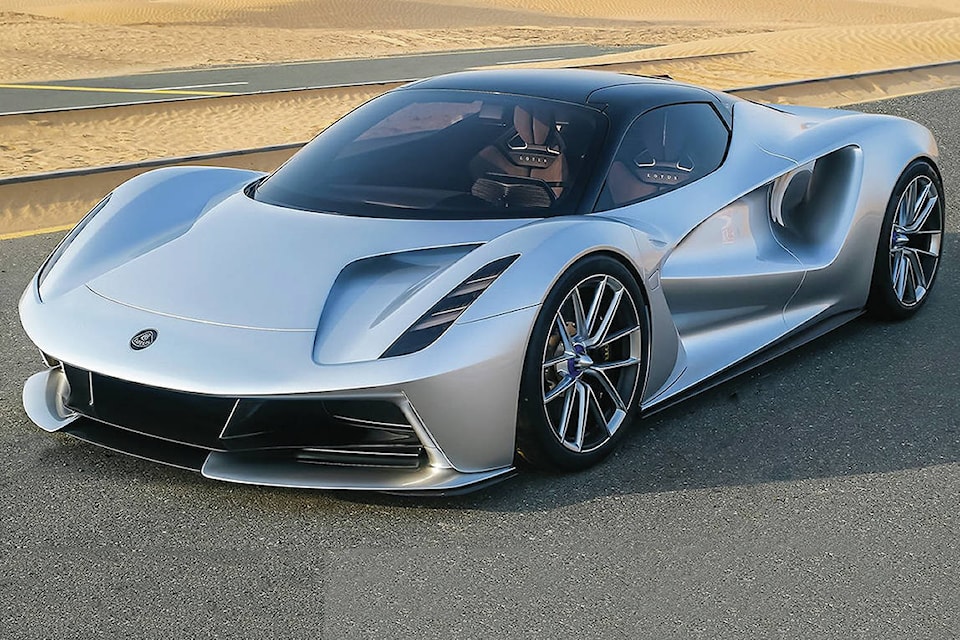Lotus is on the revitalization track:
The vehicle lineup of the British car company founded by the late Colin Chapman (and now controlled by Geely of China, which also owns Volvo) is being overhauled. On the chopping block are the Lotus Exige, Elise and Evora two-seaters, the latter being the only model currently available in North America. The Evija, a battery-electric vehicle, will launch later this year. According to Lotus, it will produce close to 2,000 horsepower and more than 1,250 pound-feet of torque. Another new sports car, referred to as the Type 131, will be built on a unique platform and will use a hybrid power system. Also in the pipeline is a utility vehicle to be built at Geely’s manufacturing facility in China. All upcoming Lotus variants are expected to be available in North America.
***

GM plans 100-per-cent-zero-emission vehicle sales by 2035
In a mere 14 years, the automaker intends to sell its very last internal-combustion-powered passenger vehicle. GM CEO Mary Barra said, however, that in some instances where the technology doesn’t exist by then, the company will purchase offsetting carbon credits and/or initiate “carbon capture” procedures. “Our preference will always be for removal of emissions,” Barra said. “This is a critical step on the path to a net-zero-carbon future.” General Motors currently sells the Chevrolet Bolt EV, but a number of additional battery-electric vehicles of all types are in the pipeline from the company and are expected to begin arriving for the 2022 model year.
***
The Expedition is coming in for significant updating
The Sleuth has learned that Ford’s big utility vehicle (and competitor to the Chevrolet Tahoe and Suburban) will sport new looks inside and out for 2022. Changes include a new front-end design and a new dashboard for the cabin, incorporating an oversize tablet-style touch-screen. For propulsion, the current twin-turbocharged 3.5-litre V-6 with 375 horsepower and 470 pound-feet of torque is expected to return, while a hybrid system rated at 430 horsepower and 570 pound-feet (optional in the 2021 Ford F-150) is rumoured to be coming to the Expedition’s option list.
***
Hydrogen or battery-electric for commercial vehicles?
The Sleuth notes that General Motors will supply hydrogen-fuel-cell stacks to truckmaker Navistar for use in an upcoming Class 8 big rig. After testing has been completed, Navistar plans to have the vehicle up and running by 2024. Sweden-based Scania, rated as the world’s 10th largest large-truck maker, has tested both hydrogen and battery-electric power systems and has instead decided to stick with batteries. Which is better? Scania says that it takes three times as much renewable energy to power its trucks with hydrogen as opposed to battery-electric power. Also noted was the cost and complexity of hydrogen-vehicle production plus concerns about the volatility of the fuel.
***

Has the next Nissan Frontier just been revealed?
That appears likely, The Sleuth surmises, after viewing images of the 2021 Nissan Navara that was recently unveiled in the Philippines. Although that vehicle is clearly intended for markets outside North America, the 2022 Frontier that launches later this year will likely use the same body-on-frame construction. The bodywork could also carry over to the Frontier. The one major difference will be in the engine compartment where the current Frontier’s 310-horsepower 3.8-litre V-6 will carry over. The Navara gets a turbo-diesel. Both of the Frontier’s extended King Cab and four-door Crew Cab models will also continue to be offered.
UPS AND DOWNS

Up: A new production-car land-speed record has been set: SSC North America, based in Washington state, can now claim bragging rights for this accomplishment. On Jan. 17, over a 2.3-mile (3.7-kilometre) straightaway, a two-way average speed of 282.9 mph (452 km/h) was achieved in one of the company’s US $1.9-million midengine Tuatara supercars. The two-seater is equipped with a twin-turbocharged 5.9-litre V-8 rated at 1,750 horsepower and 1,280 pound-feet of torque. The speed bested the previous 277.9 mph (445 km/h) record set by a Koenigsegg RS in 2017.
– written by Wheelbase Media
If you’re interested in new or used vehicles, be sure to visit TodaysDrive.com to find your dream car today! Like us on Facebook and follow us on Instagram
